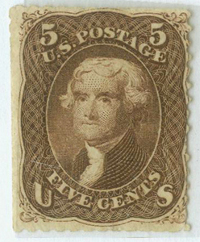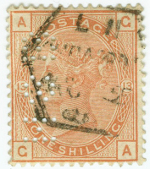
Discussion - Member to Member Sales - Research Center

Discussion - Member to Member Sales - Research Center

all British stamps can be soaked in the normal way except the self-adhesive issues, with 1st class stamps you have to be careful that you separate the ordinary from s/a issues, I usually look at the perfs with a magnifying glass if they are very neat it's probably s/a the ordinary gummed stamps will have more ragged perfs where they have been torn.

Login to Like
this post

10:13:00am
This was in a similar discussion so I've repeated it here since it seems to be more related to the GB stamps area.
************************************************
It's Like Magic - Removing Self-Adhesive Stamps from Paper (if you must)
" ... How do you know which stamps of Great Britain can not be soaked off paper with water? ..."
Look at the perforation's teeth. If they are ragged from being torn apart they are probably water soluble.
If they are simulated by a die cutting process they are almost guaranteed to be stickies and not water soluble.
With the Machins there are several different die cuttings. Two look like an undulating "SINE" wave with the curve and spacing between peaks slightly different. The third looks similar but the peaks are capped (trimmed ) much like one might expect at the top of a castle's walls.

Login to Like
this post

12:04:57pm
In the previous post I mentioned that the Machins often have different simulated perforations due to different printers using different die cutters. I knew I had a jpg showing a side by side comparison of them from somewhere and last night I noticed the file:

I do not recall where I found it, or I'd credit the fellow who made the overlay. I thought it helpful enough to print the jpg on a half page and insert it my Machin notebook in the section where such interesting information is found.
Beside these obvious differences of shape the Deegam's Handbook mentions and illustrates the different corner shapes which he identifies as; Straight ("Or almost so"), Quadrant and Dagger. That observation can be combined with the perforation shapes in helping to identify an individual used Machin stamp as to printer and issue of the recent die cut stamps.

Login to Like
this post
Have added to this post as could not find anything more relevant.
Have been soaking a lot of penny reds that were hinged on old album pages, to be remounted in plate number order.
Soaked in tepid water then rinsed in cold water, set to dry as usual, 2 hours later all but 4 stuck fast to paper. Back to soaking and removing stuck paper, any found to be at all slippery gently rubbed between thumb and finger. Rinsed through three changes of water, only to have a number stick yet again.
What gum did they use, it seems particularly tenacious, never had this problem on anything else that I have soaked.
Anyone else had a problem with this issue?

Login to Like
this post
Vic, I know what you mean. Old Austrian or Hungarian stamps are also a pest to soak. I suspect that they used a glue based on gelatin instead of dextrine or gum arabic.
Maybe you could try letting the stamps become almost dry in the open, then put a sheet of polythene foil against the gum side and dry blotting paper against the picture side and let them dry blotting paper up. Stamp glue does not adhere well to polythene, the stamps might then just snap off when you bend the foil.

Login to Like
this post
I have had this same problem with some US stamps that were hinged in old approvals books. Some still had traces of gum that persisted even after the hinges soaked off.
I tried progressively warmer water until the gum dissolved. A few took water that was almost boiling (not recommended but by then I was just experimenting). The hot water didn't seem to affect the stamps at all, and once the gum was finally removed they dried and pressed flat just fine.
Sally

Login to Like
this post
When the water that early Machins is just a bit too hot when soaking, it reacts with the phosphor turning it white and powdery....

PRINZ uhu HINGE REMOVER works well on wateractivated. It preserves gum. So may be used to recover mint-hinged, or gum problems....Otherwise heptane for security machins ...

Login to Like
this post

re: Soaking Stamps GB other than Machins
all British stamps can be soaked in the normal way except the self-adhesive issues, with 1st class stamps you have to be careful that you separate the ordinary from s/a issues, I usually look at the perfs with a magnifying glass if they are very neat it's probably s/a the ordinary gummed stamps will have more ragged perfs where they have been torn.

Login to Like
this post
Silence in the face of adversity is the father of complicity and collusion, the first cousins of conspiracy..
26 Feb 2014
10:13:00am
re: Soaking Stamps GB other than Machins
This was in a similar discussion so I've repeated it here since it seems to be more related to the GB stamps area.
************************************************
It's Like Magic - Removing Self-Adhesive Stamps from Paper (if you must)
" ... How do you know which stamps of Great Britain can not be soaked off paper with water? ..."
Look at the perforation's teeth. If they are ragged from being torn apart they are probably water soluble.
If they are simulated by a die cutting process they are almost guaranteed to be stickies and not water soluble.
With the Machins there are several different die cuttings. Two look like an undulating "SINE" wave with the curve and spacing between peaks slightly different. The third looks similar but the peaks are capped (trimmed ) much like one might expect at the top of a castle's walls.

Login to Like
this post
Silence in the face of adversity is the father of complicity and collusion, the first cousins of conspiracy..
10 Mar 2014
12:04:57pm
re: Soaking Stamps GB other than Machins
In the previous post I mentioned that the Machins often have different simulated perforations due to different printers using different die cutters. I knew I had a jpg showing a side by side comparison of them from somewhere and last night I noticed the file:

I do not recall where I found it, or I'd credit the fellow who made the overlay. I thought it helpful enough to print the jpg on a half page and insert it my Machin notebook in the section where such interesting information is found.
Beside these obvious differences of shape the Deegam's Handbook mentions and illustrates the different corner shapes which he identifies as; Straight ("Or almost so"), Quadrant and Dagger. That observation can be combined with the perforation shapes in helping to identify an individual used Machin stamp as to printer and issue of the recent die cut stamps.

Login to Like
this post

re: Soaking Stamps GB other than Machins
Have added to this post as could not find anything more relevant.
Have been soaking a lot of penny reds that were hinged on old album pages, to be remounted in plate number order.
Soaked in tepid water then rinsed in cold water, set to dry as usual, 2 hours later all but 4 stuck fast to paper. Back to soaking and removing stuck paper, any found to be at all slippery gently rubbed between thumb and finger. Rinsed through three changes of water, only to have a number stick yet again.
What gum did they use, it seems particularly tenacious, never had this problem on anything else that I have soaked.
Anyone else had a problem with this issue?

Login to Like
this post

re: Soaking Stamps GB other than Machins
Vic, I know what you mean. Old Austrian or Hungarian stamps are also a pest to soak. I suspect that they used a glue based on gelatin instead of dextrine or gum arabic.
Maybe you could try letting the stamps become almost dry in the open, then put a sheet of polythene foil against the gum side and dry blotting paper against the picture side and let them dry blotting paper up. Stamp glue does not adhere well to polythene, the stamps might then just snap off when you bend the foil.

Login to Like
this post

re: Soaking Stamps GB other than Machins
I have had this same problem with some US stamps that were hinged in old approvals books. Some still had traces of gum that persisted even after the hinges soaked off.
I tried progressively warmer water until the gum dissolved. A few took water that was almost boiling (not recommended but by then I was just experimenting). The hot water didn't seem to affect the stamps at all, and once the gum was finally removed they dried and pressed flat just fine.
Sally

Login to Like
this post

re: Soaking Stamps GB other than Machins
When the water that early Machins is just a bit too hot when soaking, it reacts with the phosphor turning it white and powdery....

PRINZ uhu HINGE REMOVER works well on wateractivated. It preserves gum. So may be used to recover mint-hinged, or gum problems....Otherwise heptane for security machins ...

Login to Like
this post


